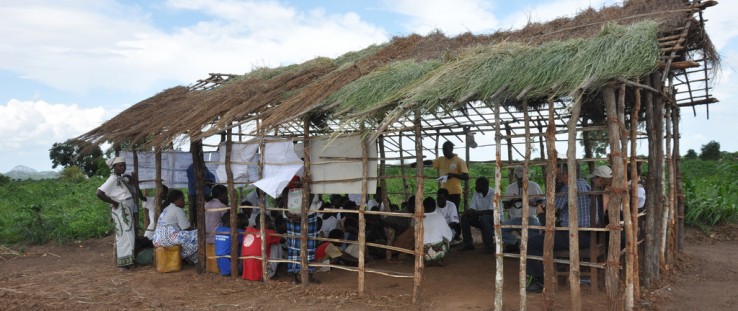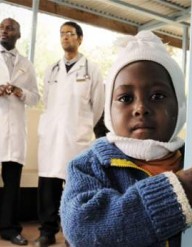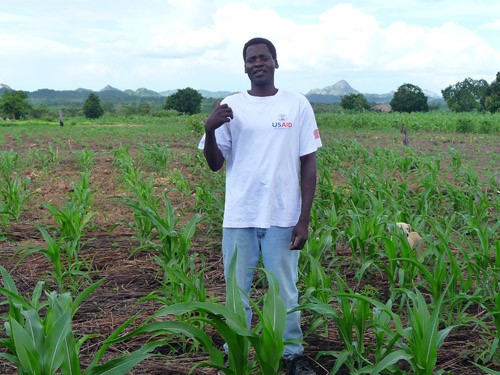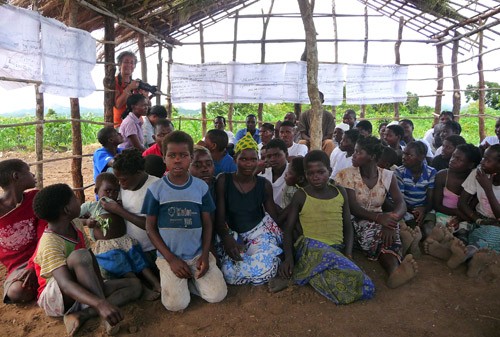 The Morrumbala community farmers' association meets to exchange best practices in this enclosure on the farm of the group's president, Davane Mesa Paulo.
Bita Rodrigues, USAID
View More Photos
The Morrumbala community farmers' association meets to exchange best practices in this enclosure on the farm of the group's president, Davane Mesa Paulo.
Bita Rodrigues, USAID
View More Photos
 The Morrumbala community farmers' association meets to exchange best practices in this enclosure on the farm of the group's president, Davane Mesa Paulo.
Bita Rodrigues, USAID
View More Photos
The Morrumbala community farmers' association meets to exchange best practices in this enclosure on the farm of the group's president, Davane Mesa Paulo.
Bita Rodrigues, USAID
View More Photos
MORRUMBALA, Mozambique—Smiling proudly, Davane Mesa Paulo points to the peanuts he grows. “That is for strength,” the 43-year-old Mozambican farmer says.
His wife, timid in front of the guests, explains how she makes enriched porridge for her six young children using those peanuts, along with maize, moringa (an edible plant), eggs, and other readily available items that her husband cultivates.
The food pyramid is not part of the Mesa Paulos’ collective wisdom. Parents in this rural community off the grid in northern Mozambique do not slip apples into lunch boxes, and are not engaged in the nightly battle over a mandatory serving of greens.
But Mesa Paulo and his wife do know that children should not be brought up on a diet of maize alone, as is customary. They have learned to reject the traditional myth that pregnant women should not eat eggs (for fear it causes babies to be born hairless), recognizing them as an important source of protein.
It is January 2011. The poor family is well-fed. They are also healthy, but that has not always been the case. Their status can largely be attributed to a U.S. Government food security program funded by USAID, through its Office of Food for Peace.
Over its 25-year history in Mozambique, the Food for Peace program has made great gains. It has also proven remarkably adaptable to the country’s changing needs.
“Food Is Peace”
“Food is strength, and food is peace, and food is freedom, and food is a helping hand to people around the world whose good will and friendship we want.”
President John F. Kennedy spoke those words in 1961 as he rechristened the U.S. Government’s flagship foreign food aid program Food for Peace, which for the seven years after President Dwight D. Eisenhower signed the bill into law in 1954 operated under the less sexy name, the Agricultural Trade Development and Assistance Act.
Against the backdrop of the Marshall Plan, the program—which is also known by a third name, Public Law 480—was devised as a way to give U.S. farmers an outlet for their surplus produce while helping to feed hungry populations (mainly in war-ravaged Europe). Its intentions were both humanitarian and protectionist.
In 50 years, Food for Peace has been the U.S. Government’s largest and longest-running tool to combat global hunger and has assisted around 3 billion people. But in many places, the program has become a much more versatile development tool than was envisioned half a century ago.
The Food for Peace program in Mozambique today looks very different than when it began, mainly, as a vehicle to distribute rations to a population in crisis. Currently, program resources are used to fund a broad range of activities—among them agricultural development, health, hygiene, and nutrition. The object is to help the country stand on its own, moving it further along the trajectory from relief to sustainable development.
In Morrumbala, a village in northern Zambezia province, the Mesa Paulos and several other families are gracious beneficiaries. But they are no longer accepting handouts.
Knowledge Lost
Mozambique can claim a rich agricultural history. Today, post-conflict, it boasts a vast, albeit largely unmet, agricultural potential. More than three-fourths of the population engage in farm work, although almost entirely to make ends meet.
During 15 years of civil war, starting two years after Mozambique gained independence from Portugal in 1975, much of the country’s farming skills were lost—simple techniques like planting in rows, and more complex ones, like animal traction, disappeared.
And despite the country’s natural bounty, around half of all Mozambican children under 5 are malnourished. In many of these cases, even if their parents grow everything necessary to keep them healthy and strong, they are not getting the nutrients they need.
Throughout one of Mozambique’s poorest but most fertile provinces, Zambezia, one of the ways USAID and its partners World Vision and the Adventist Development and Relief Agency, or ADRA, are helping farmers regain that lost knowledge is by promoting community farmers’ associations. Trained volunteers spread messages in their communities, often through community theater.
Through this model, farmers learn conservation techniques for arid climates. They are shown better growing techniques and given access to better seed. They learn that pooling their crops brings better prices in the marketplace.
But the community model is not only for male farmers. And its lessons do not only relate to farming. There’s a community nutrition group, made up of mostly mothers. But surprisingly, some of the men are also members. And when the farmers’ and mothers’ groups interact, larger messages break through.
Life-Saving Links
Both parents are being taught the links between the food they grow and their children’s nutrition through a system of integrated and repeated messages.
Mothers learn the importance of breastfeeding, and how to make vitamin-packed enriched porridge using locally grown crops. They learn that boiling water and using latrines curtail illness. They even learn how to monitor a child’s nutrition by looking at their hair or skin (lightened hair or skin problems being indicators of micro-nutrient deficiency). They are encouraged to make regular trips to health centers to monitor their children’s growth.
Using the community-model approach, a program devised primarily as a way to assuage hunger during times of crisis is now focused almost exclusively on health, hygiene, and nutrition, as well as agricultural risk management. It has been a marked and successful transition from disaster response to sustained development.
Mozambique’s Food for Peace officer, Bill Hagelman, explains: “Over the past 25 years, the role of this program has changed as Mozambique has gotten back on its feet and as Mozambicans have gotten back on their feet once again. So after free general distributions during that terrible time [following the civil war], we transitioned into food-for-work activities.”
The next step, Hagelman says, was to move away from hand-outs altogether and towards more sustainable activities. In fact, as Mozambique began to emerge out of crisis, and the situation changed, handing out food was no longer the appropriate thing to do.
“People would stop working in their fields,” explains Brian Hilton, World Vision’s food security coordinator and a 16-year resident of Mozambique. “It causes all kinds of problems.”
Fully Monetized
Today, and in the absence of an emergency, the Food for Peace program in Mozambique does not distribute any food directly. As a fully monetized program, 100 percent of the U.S.-donated commodity, which in this case is wheat, is sold with the proceeds put towards more advanced development goals.
“The wheat is shipped over on U.S. carriers. When the wheat gets here, we sell it to millers,” says Hilton. The proceeds are then distributed to NGOs.
While full monetization is controversial in some circles, in Mozambique it is working surprisingly well. The high-quality wheat is sold to local millers, who maintain Mozambique´s bread-loving culture, a Portuguese inheritance. But because there is scant wheat grown in Mozambique, the commodity does not distort local markets.
Hagelman argues that while full monetization may not fit every model, it is the right formula for Mozambique today. “We are at the point where [food distribution is] no longer required for mothers to have healthy children because they’ve learned what the food groups are and that they have access to those food groups, either because they grow it or because it’s available in the market,” he says.
Hunger on the Run
Mozambique was colonized for nearly 500 years, between 1505 and the country’s hard-fought independence in 1975. The after-effects of colonization, the post-independence civil war, and devastating floods in 2000 are still felt.
Although there have been overall economic gains, Mozambique is still one of the world’s poorest countries, and its agriculture industry still suffers from inadequate infrastructure, commercial networks, and investment.
But in Morrumbala, it is hard to imagine that hunger once reigned.
“In the beginning, we used to monitor three different indicators, one was the number of hungry months, one was the nutritional status of children under 5, and one was household incomes,” says Hagelman. “We no longer even monitor the number of hungry months because it’s negligible at this point.”
Proof of this success is Davane Mesa Paulo, who heard about USAID’s program in 2003. Back then, he struggled to support three kids and a wife on a single hectare of land where he grew just a few crops for food.
Eight years later, he is a portrait of small-scale agricultural success. He has diversified his crop portfolio. Early profits from better growing methods enabled him to buy more land. With the extra cash, he bought a bike and a radio. He now even owns chickens and goats, both considered luxuries, but critical to a balanced diet and important income generators.
Even more crucially, his six children are healthy. Because of the community association, his wife understands the importance of breastfeeding, of eating healthy, especially when she is pregnant, and of feeding their children three times a day with food that Mesa Paulo grows.
“Hunger ran away from my house,” he says. “So people started coming to ask how.”
This is, in a sense, the beauty of the community model. Neighbors see progress, and want to replicate it. In Morrumbala, enrollment in the community group has steadily grown. Plump children abound.
Behavior Change
But as Bill Hagelman says, behavior change takes time. Plump does not always equate to healthy. While the four-year program is starting to show impact as its third year draws to a close, challenges remain.
Mothers are learning the benefits of making enriched porridge for their children, but some of the nuance is still lost.
“In some communities, you can see that the rate of malnourished has decreased after using enriched porridge,” explains Maria Pinto, nutrition expert at USAID/Mozambique. “The problem is … you also have to make sure the enriched porridge is not only for the babies and the sick. It’s preventative, not curative.”
In the case of mothers with several small children, Pinto says, many will still often give the healthy mash to their infants and a vitamin deficient all-maize diet to their toddlers.
“How can we change this culture so she provides for all of them?” she asks. “It’s not easy.”
Perhaps the worst fear of those managing the Food for Peace program on the ground is that it will end before a real, sustainable, behavior sea change takes root. “The results will come at the end of the program,” says Pinto. “We can see that change is happening, but one, two years is not enough… The change we do see is at the community level. So we had 500 children, and 40 of them malnourished. Now we have 10.
“And when you ask why, they say, 'We now go to the health facility once per month, we are eating better, we can make enriched porridge,’ and they can list what the ingredients are for.”
But in some hard-to-reach pockets, progress is incremental and often delicate.
Hunger may have fled from Mesa Paulo’s home and from some of the 200,000 other households benefiting from the program across Mozambique. But health and nutrition indicators have just started to rise. A good foundation has been laid. The goal is to continue to build higher.











Comment
Make a general inquiry or suggest an improvement.